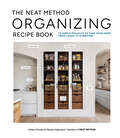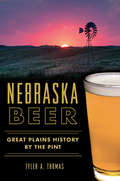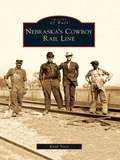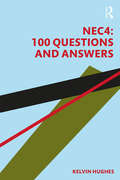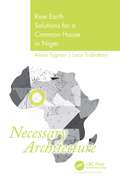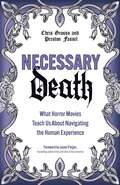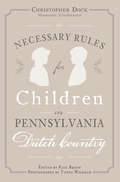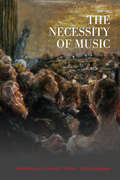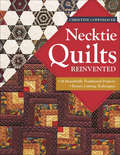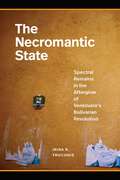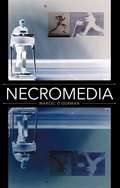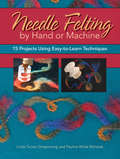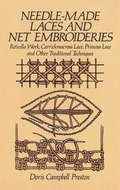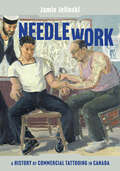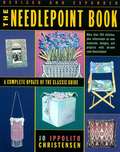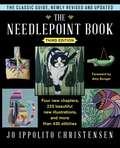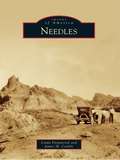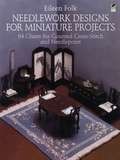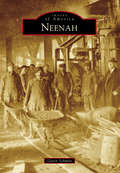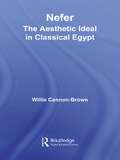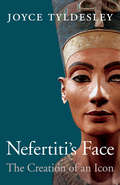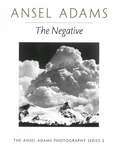- Table View
- List View
The NEAT Method Organizing Recipe Book: 70 Simple Projects to Take Your Home from Chaos to Composed
by Ashley Murphy Marissa Hagmeyer"A master class in functional style" (Billy Cotton), by the founders of NEAT Method In this one-of-a-kind organizing book, the projects are as simple as recipes, with &“ingredient&” lists and clear step-by-step directions. There are smart, stylish solutions for every room in the house, including quick wins that can be accomplished in just twenty minutes as well as larger overhauls that may take an hour or more, including: A &“drop zone&” for dirty shoes and sports gear at the garage door Compartmentalized drawers for everything from kitchen utensils to makeup to socks A color-coded bedroom closet A playroom kids will actually keep tidy And much more! The end result is transformative: By implementing solutions that emphasize beauty as much as function, you&’ll create a home that&’s well arranged, a true place of calm and simplicity.
Nebraska Beer: Great Plains History by the Pint (American Palate)
by Tyler A. ThomasNebraska's craft beer scene may be relatively young, but the state's rich brewing history stretches back to the 1800s. Tyler Thomas of NebraskaFoodie.com presents the whole story, from quenching thirsts in small towns before Prohibition to homebrewers going commercial and launching the nation's first winery/microbrewery combination. From bourgeois to blue collar, the craft breweries thriving today have distinct and entertaining stories. What drives them all are passionate people pouring their hearts into great beer, which they share one pint, pitcher or growler at a time.
Nebraska City
by Tammy PartschWhen Lewis and Clark pulled their way up the Missouri River in the summer of 1804, their journals reported an area of boundless prairie and beautiful streams on the river's west bank. Fifty years later, the community of Nebraska City was born on that very spot. For many decades, the community served as a jumping-off point for travelers bound farther westward as thousands of wagon trains departed every year. By the late 1800s, the city became known for another reason: the home of Arbor Day. First introduced by Nebraska City resident J. Sterling Morton in 1872, Arbor Day became Nebraska's holiday and is now celebrated worldwide. The 1900s saw a decline in the transportation industry but a rise in manufacturing and the growing and canning of produce. Today, historical tourism makes up the economic lifeblood of this small but thriving community.
Nebraska's Cowboy Rail Line
by Keith TerryNebraska's Cowboy Line existed for nearly 125 years and covered more than 400 miles as it made its way across the northern portion of the state. The construction of the rail line, which started in 1869, was the impetus for the establishment of many towns, and even the relocation of some, along the route. The line was employed to transport miners to the Black Hills during the gold rush of the late 1800s, it carried thousands of Irish and German immigrants to the largely unsettled area, and it allowed politicians to meet their constituents. It also was used to deliver necessities, amusements, technology, and new innovations to the state's citizenry.
NEC4: 100 Questions and Answers
by Kelvin HughesThis book details some of the most important and interesting questions raised about the NEC4 family of contracts and provides clear, comprehensive answers to those questions. Written by an NEC expert with over 20 years’ experience using, advising and training others, the book has several distinctive features: It covers the whole NEC4 family It is written by a very experienced NEC author who explains sometimes complex issues in a simple and accessible style The questions and answers range from beginner level up to a masterclass level The questions are real life questions asked by actual NEC practitioners on real projects. The book includes questions and answers relating to tendering, early warnings, programme issues, quality management, payment provisions, compensation events, liabilities, insurances, adjudication, termination and much more. It is essential reading for anyone working with the NEC4 family of contracts, whether professionals or students in construction, architecture, project management and engineering.
Necessary Architecture: Raw Earth Solutions for a Common House in Niger
by Alisia Tognon Luca TrabattoniNiger is sand, light, and heat. Starting from the necessity of the Mission Catholique du Dosso, which has worked in Niger for several years, this book speaks about the Nigerien situation which is characterized by a countrywide spread of poverty. Along with studying the country’s environmental, geographical conditions, the book discusses raw earth architecture in both vernacular and contemporary contexts. A number of the most common techniques are described. The possibilities for these methods to adapt to the contemporary language of architecture without losing the technical and physical benefits inherent in them are illustrated. The book embraces some topics that are not common but highly relevant in the Developing World, such as identity through the evolution of architecture and the value of transmitting knowledge related to the vernacular building process. Nowadays, Niger’s condition is characterized by a lack of resources, both physical and cultural. Earthen technology appears to be a valid solution in this situation for the creation of an environmentally sustainable approach. The book aims to provide an overview of the possibility of constructing new buildings related to the climate and traditional context, applying vernacular technology and solutions in a contemporary application. Providing a balance between teaching vernacular knowledge and the contemporary architectural language could help face this out-of-resource situation, aiming to get comfortable and affordable living spaces.
Necessary Death: What Horror Movies Teach Us About Navigating the Human Experience
by Preston Fassel Chris GrossoBased on very real and practical commentary, life experience, and occasionally, tongue-in-cheek-misfortunes of horror legends, Necessary Death explores how the horror genre, its motifs, and its characters offer individuals a unique opportunity for insight and understanding of their own lives.Necessary Death looks back on several iconic horror films and finds that maybe the genre wasn&’t ever really just about men in hockey masks chasing good looking coeds through old dark houses. Even a cursory examination of the horror convention will reveal a plethora of stories from recovering addicts, survivors of trauma and sexual abuse, LGBTQIA+ individuals, and minorities. So what, then, can this genre so concerned with death teach us about being alive—and how can we apply those lessons in our day-to-day existence? Using some of the most quintessential movies in the genre, Chris Grosso and Preston Fassel invite readers to an in-depth examination of the human condition—its fears, anxieties, hopes, joys, sorrows, and everything in-between—and how it&’s all grist for our personal and collective evolutionary mill. A hallmark of the genre is how horror films force their characters to find some semblance of inner strength and wherewithal in order to stand up to the monster, ghost, or villain that is trying to take their lives. Through fascinating discussion of this and other elements, Fassel and Grosso relate these films&’ dark subject matter and characters to real world issues people face every day, showing that there&’s something deep within us that, if even just metaphorically, can relate to the pain in these stories. This sharp analysis is complimented by exercises that prompt readers to consider gratitude, forgiveness, determination, and bravery in the face of adversity. An unusual mix of film study and self-help, Necessary Death might surprise or even shock readers, but it will also enlighten, educate, and most importantly hearten those looking for an unexpected source of inspiration.
Necessary Rules for Children in Pennsylvania Dutch Country
by Christopher DockMennonite schoolmaster Christopher Dock first published his A Hundred Necessary Rules of Conduct for Children in 1764. It instructed children how to keep their belongings tidy, behave in public and stay awake in church. While even the best-behaved Mennonite boy couldn't resist the allure of a well-placed puddle, the schoolmaster laid out helpful guidelines. Schoolteacher Paul Breon brings the rules into context for today's children and parents in Necessary Rules for Children in Pennsylvania Dutch Country, with charming period photography by Tonya Wilhelm. Rediscover timeless wisdom in the first guide to etiquette published in the American colonies.
The Necessity of Art: A Marxist Approach
by Ernst Fischer Anna BostockThe author, an Austrian poet and critic, surveys the whole history of artistic achievement through Marxist eyes.
The Necessity of Music: Variations on a German Theme
by Celia ApplegateIn The Necessity of Music, Celia Applegate explores the many ways that Germans thought about and made music from the eighteenth- to twentieth-centuries. Rather than focus on familiar stories of composers and their work Applegate illuminates the myriad ways in which music is integral to German social life. Musical life reflected the polycentric nature of German social and political life, even while it provided many opportunities to experience what was common among Germans. Musical activities also allowed Germans, whether professional musicians, dedicated amateurs, or simply listeners, to participate in European culture. Applegate’s original and fascinating analysis of Mendelssohn, Schumann, Brahms, Wagner, and military music enables the reader to understand music through the experiences of listeners, performers, and institutions. The Necessity of Music demonstrates that playing, experiencing, and interpreting music was a powerful factor that shaped German collective life.
Necktie Quilts Reinvented: 16 Beautifully Traditional Projects * Rotary Cutting Techniques
by Christine Copenhaver“New ideas for quilting with ties . . .projects include covers, wall-hangings, runners, and pillows.” —Publishers WeeklyAs life gets less formal, neckties don’t get worn like they used to, leaving us with a stash of unused ties. Recycle those lonely ties into 16 spectacular quilts and home accessories that look nothing like the typical stodgy necktie quilt! Showcase the rich colors, patterns, and textures found in ties with striking Hexagons, Log Cabins, Lone Stars, Flying Geese, and more. Learn how to wash ties, cut them, create appealing color combinations, and tame slippery fabric for quilting. Tie quilts make uniquely personal Father's Day, birthday, or any-occasion gifts for the tie-wearers (or former tie wearers) in your life—and this book is filled with projects for both beginners and experienced quiltmakers.
The Necromantic State: Spectral Remains in the Afterglow of Venezuela's Bolivarian Revolution
by Irina R TroconisIn the spring of 2013, televisions across Venezuela announced the death of then-president Hugo Chávez, leader of the Bolivarian Revolution and key political actor in Latin America’s “turn to the left.” Chávez’s death, however, was not the end of Chávez’s life. In The Necromantic State, Irina R. Troconis examines how Chávez, as a “specter,” has lingered in Venezuela’s public, private, and digital spaces. Focusing on contemporary Venezuela and drawing from a diverse corpus that includes tattoos, toys, memes, graffiti, and a hologram haunting the streets of downtown Caracas, Troconis contends that, in moments of failed transitions, political tensions, and crises of legitimacy, the state brings the dead back to life to negotiate the terms of its survival. By showing how this necromantic performance enables the state’s material and visual manifestations in public and private spaces, Troconis untangles a sociopolitical moment in which the ghostly acts as the affective, social, and political force that grounds state authority and ensures the preservation of the status quo, as it circumscribes acts of political imagination and limits popular resistance.
Necromedia (Posthumanities #33)
by Marcel O'GormanIn Necromedia, media activist Marcel O&’Gorman takes aim at &“the collusion of death and technology,&” drawing on a broad arsenal that ranges from posthumanist philosophy and social psychology to digital art and handmade &“objects-to-think-with.&” Throughout, O&’Gorman mixes philosophical speculation with artistic creation, personal memoir, and existential dread. He is not so much arguing against technoculture as documenting a struggle to embrace the technical essence of human being without permitting technology worshippers to have the last word on what it means to be human.Inspired in part by the work of cultural anthropologist Ernest Becker, O&’Gorman begins by suggesting that technology provides human beings with a cultural hero system built on the denial of death and a false promise of immortality. This theory adds an existential zest to the book, allowing the author not only to devise a creative diagnosis of what Bernard Stiegler has called the malaise of contemporary technoculture but also to contribute a potential therapy—one that requires embracing human finitude, infusing care into the process of technological production, and recognizing the vulnerability of all things, human and nonhuman. With this goal in mind, Necromedia prescribes new research practices in the humanities that involve both written work and the creation of objects-to-think-with that are designed to infiltrate and shape the technoculture that surrounds us.
The Needle and the Lens: Pop Goes to the Movies from Rock 'n' Roll to Synthwave
by Nate PatrinHow the creative use of pop music in film—think Saturday Night Fever or Apocalypse Now—has shaped and shifted music history since the 1960s Quick: What movie do you think of when you hear &“The Sounds of Silence&”? Better yet, what song comes to mind when you think of The Graduate? The link between film and song endures as more than a memory, Nate Patrin suggests with this wide-ranging and energetic book. It is, in fact, a sort of cultural symbiosis that has mutually influenced movies and pop music, a phenomenon Patrin tracks through the past fifty years, revealing the power of music in movies to move the needle in popular culture. Rock &’n&’ roll, reggae, R&B, jazz, techno, and hip-hop: each had its moment—or many—as music deployed in movies emerged as a form of interpretive commentary, making way for the legitimization of pop and rock music as art forms worthy of serious consideration. These commentaries run the gamut from comedic irony to cheap-thrills excitement to deeply felt drama, all of which Patrin examines in pairings such as American Graffiti and &“Do You Want to Dance?&”; Saturday Night Fever and &“Disco Inferno&”; Apocalypse Now and &“The End&”; Wayne&’s World and &“Bohemian Rhapsody&”; and Jackie Brown and &“Didn't I Blow Your Mind This Time?&”. What gives power to these individual moments, and how have they shaped and shifted music history, recasting source material or even stirring wider interest in previously niche pop genres? As Patrin surveys the scene—musical and cinematic—across the decades, expanding into the deeper origins, wider connections, and echoed histories that come into play, The Needle and the Lens offers a new way of seeing, and hearing, these iconic soundtrack moments.
Needle Felting by Hand or Machine: 20 Projects Using Easy-to-Learn Techniques
by Linda Griepentrog Pauline RichardsMachine felting is one of the hottest things in fiber arts, building on the rich history of hand felting. With top sewing manufacturers adding felting accessories to their lines, sewers can look to this new guide to efficiently explain this history of this practice and demonstrate the unique felting techniques which use moisture, pressure and abrasion to bind fibers together. Be inspired by the exciting projects to create felted items for the home, wardrobe and to give as gifts.
Needle-Made Laces and Net Embroideries: Reticella Work, Carrickmacross Lace, Princess Lace and Other Traditional Techniques (Dover Knitting, Crochet, Tatting, Lace Ser.)
by Doris Campbell PrestonReticella work, carricmacross lace, princess lace, and other traditional techniques developed by lace-makers in Ireland, England, Spain, and other countries resulted in finished pieces of unrivaled beauty that continue to inspire needlecrafters. Now needleworkers can learn to make exquisite lace and net embroidery in styles that originated in the centuries-old lace-making centers of Europe.This volume is a classic guide to the single-thread-and-needle styles of lace-making: complete instructions and clear stitch diagrams explain how to make both needle-run and needlepoint laces. In sections of their own, tatting and Irish crochet receive the same clear treatment. Even the fascinating history of lace-making is covered in some detail, and excellent advice on the care of lace is given in conclusion.With this versatile sourcebook for reference, you, too, can create the special pieces of a lifetime: bridal veils, elegant gowns, shirts and blouses, shawls, scarves, curtains, table and bed linens. Among the lovely lace and net embroidery designs in this easy-to-follow guide, you'll find geometrics, florals, sprays, lovers' knots and other pattern classics. The lace-making art is not lost, just waiting to be rediscovered in this wonderful volume and revived in your capable hands.
Needle Work: A History of Commercial Tattooing in Canada (McGill-Queen's/Beaverbrook Canadian Foundation Studies in Art History #44)
by Jamie JelinskiIn 1891 J. Murakami travelled from Japan, via San Francisco, to Vancouver Island and began working in and around Victoria. His occupation: creating permanent images on the skin of paying clients.From this early example of tattooing as work, Jamie Jelinski takes us from coast to coast with detours to the United States, England, and Japan as he traces the evolution of commercial tattooing in Canada over more than one hundred years. Needle Work offers insight into how tattoo artists navigated regulation, the types of spaces they worked in, and the dynamic relationship between the images they tattooed on customers and other forms of visual culture and artistic enterprise. Merging biographical narratives with an examination of tattooing’s place within wider society, Jelinski reveals how these commercial image makers bridged conventional gaps between cultural production and practical, for-profit work, thereby establishing tattooing as a legitimate career.Richly illustrated and drawing on archives, print media, and objects held in institutions and private collections across Canada and beyond, Needle Work provides a timely understanding of a vocation that is now familiar but whose intricate history has rarely been considered.
The Needlepoint Book
by Jo Ippolito ChristensenSince its original publication in 1976, The Needlepoint Book has become known as "The Black Bible" -- the one resource every aficionado of needlepoint needs to own. Completely revised and expanded, this updated edition includes your favorite features, plus: * A 16-PACE COLOR INSERT WITH ALL-NEW PROJECTS * A CRASH COURSE ON THE NEW FIBERS UPDATED INFORMATION ON MATERIALS, AS WELL AS HOW TO WORK WITH AND CARE FOR THEM * DOZENS OF NEW STITCHES AND A CHAPTER ON THE POPULAR OPENWORK STITCHES * MORE THAN 1,300 ILLUSTRATIONS * 369 STITCHES! DIAGRAMS FOR ALL PROJECTS SHOWN The Needlepoint Book covers all the information you need to learn needlepoint and improve your technique -- in a single comprehensive volume. You'll find section on: * CHOOSING THE RIGHT PROJECT * TRANSFERRING DESIGNS * ELEMENTS OF GOOD DESIGN: COLOR, PROPORTION, AND BALANCE * LEFT-HANDED NEEDLEPOINT * FINISHING TECHNIQUES * CLEANING NEEDLEPOINT * AND MUCH MORE! The Needlepoint Book is a complete guide to the craft, and the only book you'll ever need as a reference to become an expert at creating exquisite works to be treasured forever.
The Needlepoint Book: New, Revised, and Updated Third Edition
by Jo Ippolito ChristensenThe Needlepoint Book is the only needlework guide you'll ever need--now including 436 stitches and 1,680 illustrations.Since its original publication in 1976, The Needlepoint Book has become known as the bible for all stitching enthusiasts--the one resource for every needlepoint aficionado. Whether you're new to the craft or have been practicing for years, this guide covers your stitching journey from inspiration to achievement with specific guidelines on how to make the painted canvas yours. Featuring all-new projects and stitch patterns for every level of expertise, you will learn practical skills, such as how to: - Choose your project with purpose - Tell its story with stitches and fibers - Create mood with color and texture - Fill that blank background - Select and use embellishments such as beads and sequins Included in this revised and expanded edition is a crash course on how to use new fibers; updated information on materials, as well as how to work with and care for them; dozens of new stitches; and diagrams and stitch guides for select projects included in book. Also featured are thirty-two pages of color photographs with all-new projects; dozens of new stitches explained with photos and drawings; and a new ribbon stitch chapter. The Needlepoint Book is the one book to own on the topic. In one comprehensive volume, it has everything you'll need to create your own artistic, high-quality heirloom.
Needles
by James M. Conkle Linda FitzpatrickNeedles is located at the borders of California and Arizona on the west bank of the Colorado River, once serving as an important transportation hub in California. During the mid-1800s, the steamboat trade flourished here as gold, silver, goods, and passengers were transported along the Colorado River. The Atlantic and Pacific Railroad, now known as the Santa Fe, replaced the steamboats when tracks were laid through the area starting in 1883. The charter city was founded in 1913. America's "Mother Road," Route 66, built through downtown Needles in 1926, spurred growth as new businesses opened to serve travelers. Needles was named for its striking rock formations and is famous for its summer temperatures, but it is ultimately known and remembered as a living icon of an early 20th century town on historic Route 66.
Needlework Designs for Miniature Projects: 64 Charts for Counted Cross-Stitch and Needlepoint
by Eileen FolkThink small ... beautiful things come in miniature sizes. With this collection of over five dozen charted designs, miniature enthusiasts and needleworkers can delight in creating a panoply of Lilliputian-sized heirlooms at a fraction of store prices. Here is a treasury of decorative projects to enhance and enliven any miniature setting.Accomplished craftswoman Eileen Folk offers 64 designs that will turn ordinary dollhouse rooms into exquisite showplaces with a minimum of effort and a maximum of style. These elegant projects work up quickly -- some in as little as one hour from start to finish. All can be worked in either needlepoint or counted cross-stitch and are fully complemented by easy-to-follow directions and clear, well-rendered charts. Use suggested colors or select your own color scheme in creating a variety of attractive furnishings: rugs, pillows, upholstery, chair cushions, quilts, decorative accent pieces, place mats, window treatments, bedspreads, and even an entire nursery.The book offers both beginners and experienced needlecrafters endless hours of pleasure and unlimited creative inspiration. This charming, imaginative craft book will help you create an enchanting décor for any miniature vignette.
Neenah
by Gavin SchmittNeenah rests in the heart of the Fox Valley, positioned between Appleton and Oshkosh. The city sits at the junction of Lake Winnebago and the Fox River, which has always been central to its draw for both recreation and business. Flour and paper milling utilized the river's powerful flow and brought Neenah's biggest booms. The successes of paper mills such as Neenah Paper, which opened in 1866, and the Kimberly-Clark Corporation, which opened in 1872, led to the natural development of the "Paper City" nickname. Today, industry continues to flourish in Neenah. The region has become a hub for several major corporations with broad, international reach, yet lifelong residents remain the true community heroes. Vintage photographs highlight the notable lifestyles of Bergstrom, Aylward, and Mahler, as well as the day-to-day activities of shopkeepers, churchgoers, factory workers, teachers, deliverymen, bankers, politicians, craftsmen, and other locals who were better known as friends or neighbors. Featuring both the storefronts and aisles of popular establishments such as Krueger Hardware, Jandrey's department store, and Burts Candies, this book invites readers to take a trip down memory lane. ?.
Nefer: The Aesthetic Ideal in Classical Egypt (African Studies)
by Willie Cannon-BrownThis book provides an original treatment of the concept of good and beauty in ancient Egypt. It seeks to examine the dimensions of nefer, the term used to describe the good and the beautiful, within the context of ordinary life. Because the book is based upon original research on ancient Egypt it opens up space for a review of the aesthetics of other African societies in the Nile Valley. Thus, it serves as a heuristic for further research and scholarship.
Nefertiti’s Face: The Creation of an Icon
by Joyce TyldesleyLittle is known about Nefertiti, the Egyptian queen whose name means “a beautiful woman has come.” She was the wife of Akhenaten, the pharaoh who ushered in the dramatic Amarna Age, and she bore him at least six children. She played a prominent role in political and religious affairs, but after Akhenaten’s death she apparently vanished and was soon forgotten. Yet Nefertiti remains one of the most famous and enigmatic women who ever lived. Her instantly recognizable face adorns a variety of modern artifacts, from expensive jewelry to cheap postcards, t-shirts, and bags, all over the world. She has appeared on page, stage, screen, and opera. In Britain, one woman has spent hundreds of thousands of pounds on plastic surgery in hope of resembling the long-dead royal. This enduring obsession is the result of just one object: the lovely and mysterious Nefertiti bust, created by the sculptor Thutmose and housed in Berlin’s Neues Museum since before World War II. In Nefertiti’s Face, Egyptologist Joyce Tyldesley tells the story of the bust, from its origins in a busy workshop of the late Bronze Age to its rediscovery and controversial removal to Europe in 1912 and its present status as one of the world’s most treasured artifacts. This wide-ranging history takes us from the temples and tombs of ancient Egypt to wartime Berlin and engages the latest in Pharaonic scholarship. Tyldesley sheds light on both Nefertiti’s life and her improbable afterlife, in which she became famous simply for being famous.
The Negative (Trilogía Fotográfica De Ansel Adams #Vol. 2)
by Ansel Adams Robert BakerThe early chapters are devoted to a discussion of light, film and exposure. What follows is a detailed discussion of the zone system, chapters on natural and artificial light and at the end is an extensive chapter on the darkroom and its equipment.
